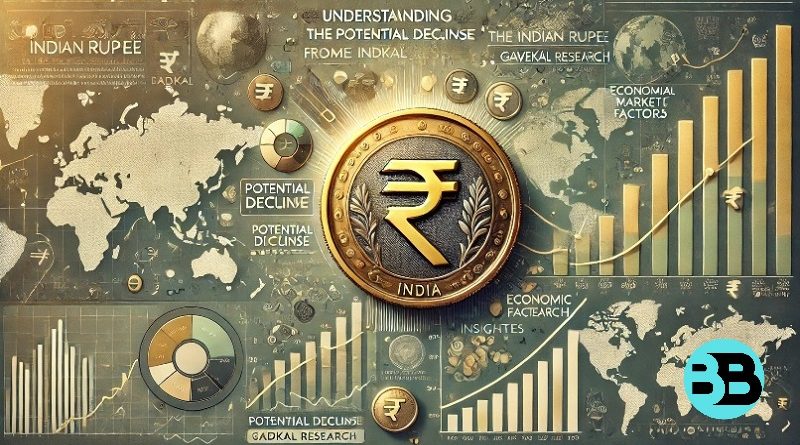The Future Downslide of Indian Rupee
Conclusion: The fall of the rupee, if retrogressed from $90 to the US dollar, will reflect, like many global events, the pulls of the various countries’ economic relations, and national level competition that countries embark on in regard to economic affairs. It is a risk. Even so, it also offers the opportunity for India to back her basic economic fundamentals, as she has been doing in the past on domestic fronts. It is only the calibrated and well-informed policies that India must take to address the structural problems that indeed create some impediments in the direction of economic revival.
The Indian rupee has ever been a subject of wonder and mystery for economists and investors because of its significance in the global monetary context and from the point of view that it is a mirror of India’s economic health. Witnesses to this fact have been analysts from Gavekal Research, who have recently predicted cowering below 90 per U.S. dollar in 2025. They point out that this is from the unsubtle and strategic shift of refinements adopted by the Reserve Bank of India (RBI) from an implicit quasi-peg to the United States dollar and other macro-economy facets. The bounds to this outlook along with the broader implications and the very outcome to India’s economy and foreign stakeholders lie in this piece.
What is Quasi-Pegging to the Dollar?
Following what Quasi-Peg to the Dollar really is could explain potential depreciation of the rupee. In the historical context, the central bank has been used to the managed exchange rate policy; this facilitated a gap where between free-floating and an absolute dollar peg was allowed. Instead, the RBI could intervene in forex market merely to strengthen relative stability, thus preventing any likely extravagant bursting that can destabilize the economy.
However, some emerging views from analysts might argue differently as they note recent actions on the part of RBI to imply, in fact, it is somewhat liberating away from this management strategy in a gradual process. The central bank wants, by building more flexibility in the management of exchange rates, that the rupee should proceed in accordance with market forces and not totally on the guarded trajectory or tenacity controlled by itself active management of this trajectory. That means more lessons of market manipulation and global exposure to the rupee.
Triggering Events Behind Prediction of Rupee’s Fall
The following contribute to a significant depression in the projection of the Indian currency:
1. Monetary Policy Divergence
U.S. Federal Reserve interest rate raising has continually pushed up the dollar, making it favorable to the global investor. When the RBI holds back, it seems like as if it could hinder the home economy. This disparity in monetary policies thus widens the space between the two currency poles.
2. Export-Trade and Current Account Deficits
With substantial imports from abroad—oil and gold have a history of maximally buttressing the trade deficit of the nation – India is constantly at liability concerning its trade, constantly influencing the depreciation of the rupee. Further reasons are the huge CAD, from which capital inflow is beating the capital outflow. A wider CAD definitely increases an additional downward pressure on the rupee, making it quite vulnerable to depreciation.
3. Geo-Political Issues
Geopolitical tensions, such as the Russia-Ukraine war and their implications on U.S.-China double standards, have thrown the global economy into peculiar uncertainties. The shackled minds jiolted in panic to secure invested assets in the comfort of the dollar’s further strengthening, while those with something in yuan or Rupee may just have to face downward pressures.
4. FII Outflow
The U.S. has seen better returns compared to India and other developed markets as a result of which massive FII outflows to the United States have taken place. In the case of increased capital inflow into the currency, it also Liquidates pressure on the Rupee.
5. Structural Challenges
Economic challenges, compounded by factors like inflation, low export growth, and the reluctance of private sector investment on new projects, beset India. The country continues to be more susceptible in an external shock environment.
Effects Brought About by a Softer Rupee
A rupee dip that goes south of 90 in terms of the dollar can have some far-ranging effects, such as:
1. Impact on Inflation
A soft rupee will hike the cost of imports, which includes many stakeholders and such items as crude oil. Higher oil prices can stoke inflation, damaging consumer purchasing power and overall economic growth.
2. Enduring Foreign Debt
External debt- especially dollar-amounted loans taken by India would become pricier once the rupee depreciated further. This increased cost from the depreciation of the rupee would result in additonal burden to government and corporate balance sheets.
3. Competitive Exports
On the brighter side, depreciation might make Indian exports even more competitive on the global market. The book does not mention any other information or narrative analysis of the clause. This benefits Indian IT services, textiles, and pharmaceutical sectors, which rely significantly on currencies in dollars and earn a substantial sum from them.
4. Investments
Unlike sceptical foreign investors that a weakening rupee is a potential threat to investments, long-run investors may view this as an acquisition opportunity for assets at very low prices.
5. Tourism and Education Costs
Higher prices would lead to higher costs for Indian students studying abroad and tourists hopping around country boundaries.
What Can the RBI Do?
The RBI is, however, discouraged from having much influence on global developments, where a few steps could be taken to curb the decline of the rupee:
1. Intervention in Forex Markets: To stabilize the rupee, the RBI might have to sell some reserves of dollars.
2. Changes to Monetary Policy: To attract foreign money, the interest could be raised, even if an impact is observed in slower economic growth.
3. Incentivize Inflows of Capital: Policies reoriented towards attracting FDI inflows and promoting remittances could lead to a neutralizing benefit in relation to trade deficits.
4. Boost Export Competitiveness: Exporters are given incentives, and imparting on diversifying of export markets; this will strengthen more foreign exchange earnings.
Learnings from the Past Depreciations
The India Rupee has gone through a lot of phases of depreciation before. Each occasion offered important feedback to policymakers:
• 2013 Beginning of the Taper Tantrums: Rupee took a huge drop during tapering of quantitative easing by the U.S. Federal Reserve, following which RBI introduced strict rate hikes and forex interventions restoring the currency.
• 2018 Skyrocketing of OIL Prices: A worldwide oil hump led to Rupee dropping. As India started to concentrate on cutting down on oil imports and promoting the import of renewable ones, the exchange value saw an easing down the pressure.In essence, these experiences point out the need for timely intervention and systemic reforms to control exchange-rate volatility.
What lies ahead?
The rupee-dollar witness lower than $90 threat concerns us; however, such forecasts should be considered within a much broader perspective-that while it would look concern-worthy now, one would need to remember that currency alone is influenced by countless unknown aspects. A leader must take immediate measures in the present plus one extreme long-term perspective for the foreseeable good fortune of his country.
Key Areas of Focus:
• Building a strong domestic economy: Improved productivity, increased exports, and reduced reliance on imports will improve market sensitivity to the different crises and pressure by the dollar.
• Expenditure Spread for Forex Reserves: Currency and assets managed at the lowest possible prices will allow you to reduce dollar dependence.
• Collaborate with other nations: Economic relations and commercial agreements with other economies would be a fruitful protection from such external vulnerabilities.




